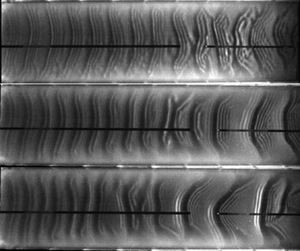Published online by Cambridge University Press: 03 January 2023

Experiments are conducted in water films falling along the bottom wall of a weakly inclined rectangular channel of height  $5$ mm in the presence of a laminar counter-current air flow. Boundary conditions have been specifically designed to avoid flooding at the liquid outlet, thus allowing us to focus on the wave dynamics in the core of the channel. Surface waves are excited via coherent inlet forcing before they come into contact with the air flow. The effect of the air flow on the height, shape and speed of two-dimensional travelling nonlinear waves is investigated and contrasted with experiments of Kofman, Mergui & Ruyer-Quil (Intl J. Multiphase Flow, vol. 95, 2017, pp. 22–34), which were performed in a weakly confined channel. We observe a striking difference between these two cases. In our strongly confined configuration, a monotonic stabilizing effect or a non-monotonic trend (i.e. the wave height first increases and then diminishes upon increasing the gas flow rate) is observed, in contrast to the weakly confined configuration where the gas flow is always destabilizing. This stabilizing effect implies the possibility of attenuating waves via the gas flow and it confirms recent numerical results obtained by Lavalle et al. (J. Fluid Mech., vol. 919, 2021, R2) in a superconfined channel.
$5$ mm in the presence of a laminar counter-current air flow. Boundary conditions have been specifically designed to avoid flooding at the liquid outlet, thus allowing us to focus on the wave dynamics in the core of the channel. Surface waves are excited via coherent inlet forcing before they come into contact with the air flow. The effect of the air flow on the height, shape and speed of two-dimensional travelling nonlinear waves is investigated and contrasted with experiments of Kofman, Mergui & Ruyer-Quil (Intl J. Multiphase Flow, vol. 95, 2017, pp. 22–34), which were performed in a weakly confined channel. We observe a striking difference between these two cases. In our strongly confined configuration, a monotonic stabilizing effect or a non-monotonic trend (i.e. the wave height first increases and then diminishes upon increasing the gas flow rate) is observed, in contrast to the weakly confined configuration where the gas flow is always destabilizing. This stabilizing effect implies the possibility of attenuating waves via the gas flow and it confirms recent numerical results obtained by Lavalle et al. (J. Fluid Mech., vol. 919, 2021, R2) in a superconfined channel.